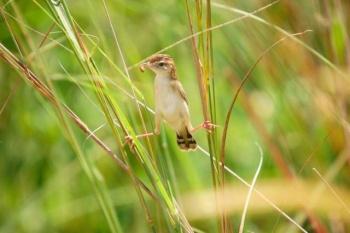Alternative name: Fan-tailed Warbler, Fan-tailed Cisticola, Streaked Fantail Warbler, Streaked Fan-tailed Warbler
Disambiguation: For the American species Euthlypis lachrymosa, see Fan-tailed Warbler
- Cisticola juncidis
Identification
Length 10-11cm (4-4¼ in), weight (male) 7-12 g (female) 5-8 g
- Sandy-brown above, heavily streaked with black on the mantle and crown
- White to buffy underparts
- Short, broad, white-tipped tail
- Bill pale yellow-buff, except for breeding male, which has a black bill
Similar species
Many other cisticola species, especially in Africa. Golden-headed Cisticola in South East Asia / Australia (which see).
Distribution
Southern Europe, Africa, southern Asia and northern Australia.
Taxonomy
This genus, along with various other mainly subtropical and tropical warbler genera, is now treated in the family Cisticolidae.
Subspecies
There are 17 subspecies[1], divided into four broad regional groups:
Mediterranean group
- C. j. cisticola:
- Coastal western France to Iberian Peninsula, Balearic Islands and north-western Africa
- C. j. juncidis:
- C. j. neuroticus:
Tropical African group
- C. j. uropygialis:
- C. j. terrestris:
South Asian group
- C. j. cursitans:
- C. j. salimalii:
- South-western India (Kerala)
- C. j. omalurus:
- C. j. malaya:
- C. j. brunniceps:
- Japan (Honshu to Ryukyu, Izu and Cheju-Do islands) to northern Philippines
- C. j. tinnabulans:
- Southern China to Indochina, Hainan, Taiwan and Philippines
- C. j. nigrostriatus:
- South-western Philippines (Culion and Palawan)
- C. j. fuscicapilla:
- Eastern Java, Kangean Islands and Lesser Sundas
- Eastern Java, Kangean Islands and Lesser Sundas
Australasian group
- C. j. constans:
- Sulawesi, Togian Island, Muna Island, Tukangbesi Island and Peleng Island
- C. j. normani:
- Coastal southern New Guinea and coastal northern Queensland
- C. j. leanyeri:
- Disjunct in coastal northern Australia to western Gulf of Carpenteria
- C. j. laveryi:
- Coastal north-eastern Queensland (Cape York Peninsula south to Keppel Island)
An 18th subspecies formerly accepted as C. j. perrenius is now treated as a synonym of C. j. uropygialis. The tropical African subspecies group at least has been suggested as a potential future split. Further studies may suggest additional splitting of this very wide-ranging and variable species.
Habitat
Open land with shrub, damp scrubby grassland, reeds, cane fields, thick brush, mangroves. Grassy coastal plains, saltmarsh etc.
Behaviour
A small warbler often seen only as a fleeting glimpse as it is a very active little bird. Some subspecies appear to be shyer than others.
Diet
Their diet consists almost entirely of insects and small invertebrates, including grasshoppers, dragonflies, moths, caterpillars and insect larvae etc. They mostly forage around the base of grass clumps, but occasionally they hawk for flying insects.
Breeding
The female builds a cup shaped nest deep in grasses, from living leaves, plant-down, cobwebs, and grass, with a canopy of tied-together leaves or grasses overhead for camouflage. Three to six eggs are laid.
Vocalisation
The male has a most distinctive song-flight. It flies in circles about 20 ft above the ground, undulating considerably. At the top of each arc it gives a series of 'zit' notes, in some subspecies a series of double 'zit-zit' notes.
Recording by Alok Tewari
Sultanpur, Gurgaon, Haryana, India, July-2016
Adult, Ssp. cursitans, calling from an acacia shrub
References

Photo by Mat & Cathy
Kakadu National Park, Northern Territory, Australia, March 2006
- Clements, J. F., T. S. Schulenberg, M. J. Iliff, S. M. Billerman, T. A. Fredericks, B. L. Sullivan, and C. L. Wood. 2019. The eBird/Clements Checklist of Birds of the World: v2019. Downloaded from http://www.birds.cornell.edu/clementschecklist/download/
- Collins Field Guide 5th Edition
- Collins Bird Guide ISBN 0 00 219728 6
- Birdforum Member observations
Recommended Citation
- BirdForum Opus contributors. (2024) Zitting Cisticola. In: BirdForum, the forum for wild birds and birding. Retrieved 20 April 2024 from https://www.birdforum.net/opus/Zitting_Cisticola
External Links
GSearch checked for 2020 platform.1








